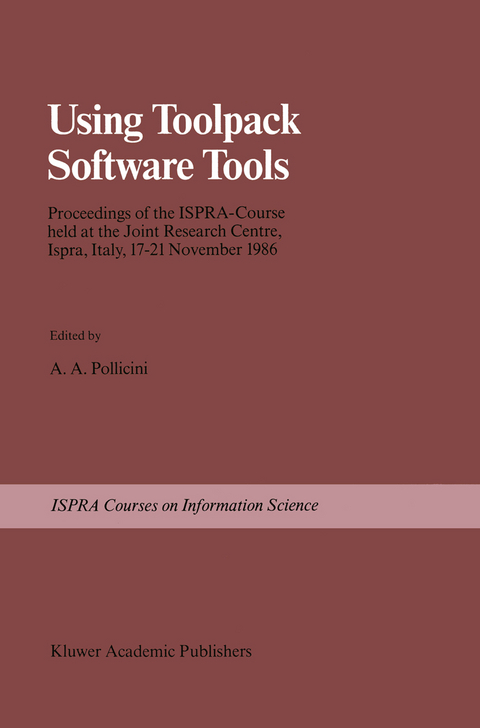
Using Toolpack Software Tools
Springer (Verlag)
978-0-7923-0033-5 (ISBN)
- Titel z.Zt. nicht lieferbar
- Versandkostenfrei
- Auch auf Rechnung
- Artikel merken
The Toolpack Project.- 1. Introduction.- 2. Toolpack/1 Services.- 4. Examples of the Use of Toolpack/1 Tools.- 5. Conclusions.- Structure of Toolpack /1 Software.- 1. Introduction.- 2. Design Overview.- 3. Conclusions.- TIE Specifications.- 1. Introduction.- 2. Overview.- 3. Evolution.- 4. Specification.- 5. Optional Extensions.- 6. Implementations.- Toolpack Invocation Techniques.- 1. Introduction.- 2. Toolpack User Interfaces.- The Toolpack / 1 Tool Suite.- 1. Command Executors.- 2. General Tools.- 3. Documentation Generation Tools.- 4. Fortran 77 Oriented Tools.- 5. Monoliths.- 6. DO Loop Unrolling Tools.- 7. Experimental Tools.- Analysis Tools for Fortran 77.- 1. Introduction.- 2. Lexical Analysis.- 3. Syntax Analysis and Transformational Grammars.- 4. Static Semantic Analysis.- 5. Approach to Portability Verification.- 6. Conclusions.- Workshop on Fortran Analysis.- 1. Introduction.- 2. ISTVS — View Symbols.- 3. ISTYW — View Warnings.- 4. ISTVA — View Attributes.- 4.1. The Extended Symbol Table.- 4.2. The Global Symbol Table.- 5. ISTAN — The Execution Analysis Tool.- The Fortran 77 Source Polisher.- 1. A Dissertation on Presentation Rules.- 2. Approaches to Tidying Source Programs.- 3. Structure of the Polishing Mechanism.- 4. ISTPL User’s Interface.- 5. ISTPO User’s Interface.- 6. When, How and Why to Change Polishing Options?.- 7. Conclusions.- Fortran 77 Transformers.- 1. Introduction.- 2. The Declaration Standardiser.- 3. The Precision Transformer.- 4. The Structurer.- Workshop on Fortran Transformations.- 1. Introduction.- 2. Internal Operation of ISTST.- 3. ISTGI — Make Intrinsics Generic.- 4. ISTFR — Real Constant Modifier.- 5. ISTJS — Join Strings in Formats.- 6. ISTME — Manipulate Expressions.- 7. ISTPP — Program Parameter Verifier.-DO Loop Transforming Tools.- 1. Introduction.- 2. The Transformations and Their Effect.- 3. Tool Integration in Toolpack/1.- 4. Parse Tree Walking and Flattening.- 5. ISTUD — The DO Loop Unrolling Tool.- 6. ISTCD — The DO Sequence Condensing Tool.- 7. ISTSB — The Substitution/Elimination Tool.- 8. Operation of the Tools.- The Toolpack/1 Editor and Other Fortran Modifiers.- 1. Introduction.- 2. Toolpack Editing.- 3. ISTED — Fortran Aware Editor.- 4. ISTCN & ISTCR — Tools for Name Changing.- Documentation and Non-Fortran Tools.- 1. Introduction.- 2. ISTRF.- 3. ISTCB.- 4. ISTTD.- 5. ISTVC.- 6. ISTDX.- 7. ISTAL.- 8. ISTDC.- 9. Conclusion.- Supporting Coding Conventions.- 1. Introduction.- 2. Coding Conventions: Elements and Implementation.- 3. ISTDS Selected Options.- 4. The Preliminary ISTPO Session.- 5. The Transformation Chain.- 6. Sample Program.- General Advice on Installing Toolpack/1.- 1. Introduction.- 2. Which version of TIE?.- 3. The Toolpack/1 Base Tape.- 4. Installing TIECODE.- 5. Installing Stand-Alone TIECODE.- 6. Supplementary Libraries.- 7. Installing Tools.- 8. Conclusions.- Tool Writing.- 1. Introduction.- 2. The Source Language for Toolpack/1 Tools.- 3. The Tool Interface to the Toolpack/1 System.- 4. Characters and Strings.- 5. Tokens, Nodes, and Symbol Attributes.- 6. Documentation for the Tool Writer.- 7. Contributing Tools to Toolpack/1.- Open Forum.- Panel and General Discussion.- The Future of Toolpack/1.- 1. Functionality.- 2. NAG Internal Use.- 3. Language Domain.- 4. User Interface.- 5. Portability.- Appendix A Toolpack /1 Contents Summary.- Numerical Algorithms Group.- Appendix B Porting Toolpack /1 to IBM MVS/TSO.- M D Dowell, P A Moinil, A A Pollicni.- 1. The Study Background.- 2. The Interface Model.- 2.1. The Mailbox Model.- 2.2.The Front-end Model.- 3. The Interface Software.- 3.1. The Engine TSOBOX.- 3.2. The Surrounding Structure.- 4. The Front-end Documentation.- 4.1. Customization and Target Characterization.- 4.2. Disclaimer.- 4.3. Tape Format.- 4.4. Tape Contents.- Bibliographic References.
| Erscheint lt. Verlag | 31.12.1988 |
|---|---|
| Reihe/Serie | Ispra Courses |
| Zusatzinfo | 360 p. |
| Verlagsort | Dordrecht |
| Sprache | englisch |
| Themenwelt | Mathematik / Informatik ► Informatik ► Software Entwicklung |
| Informatik ► Theorie / Studium ► Compilerbau | |
| Mathematik / Informatik ► Mathematik ► Analysis | |
| ISBN-10 | 0-7923-0033-5 / 0792300335 |
| ISBN-13 | 978-0-7923-0033-5 / 9780792300335 |
| Zustand | Neuware |
| Informationen gemäß Produktsicherheitsverordnung (GPSR) | |
| Haben Sie eine Frage zum Produkt? |
aus dem Bereich


